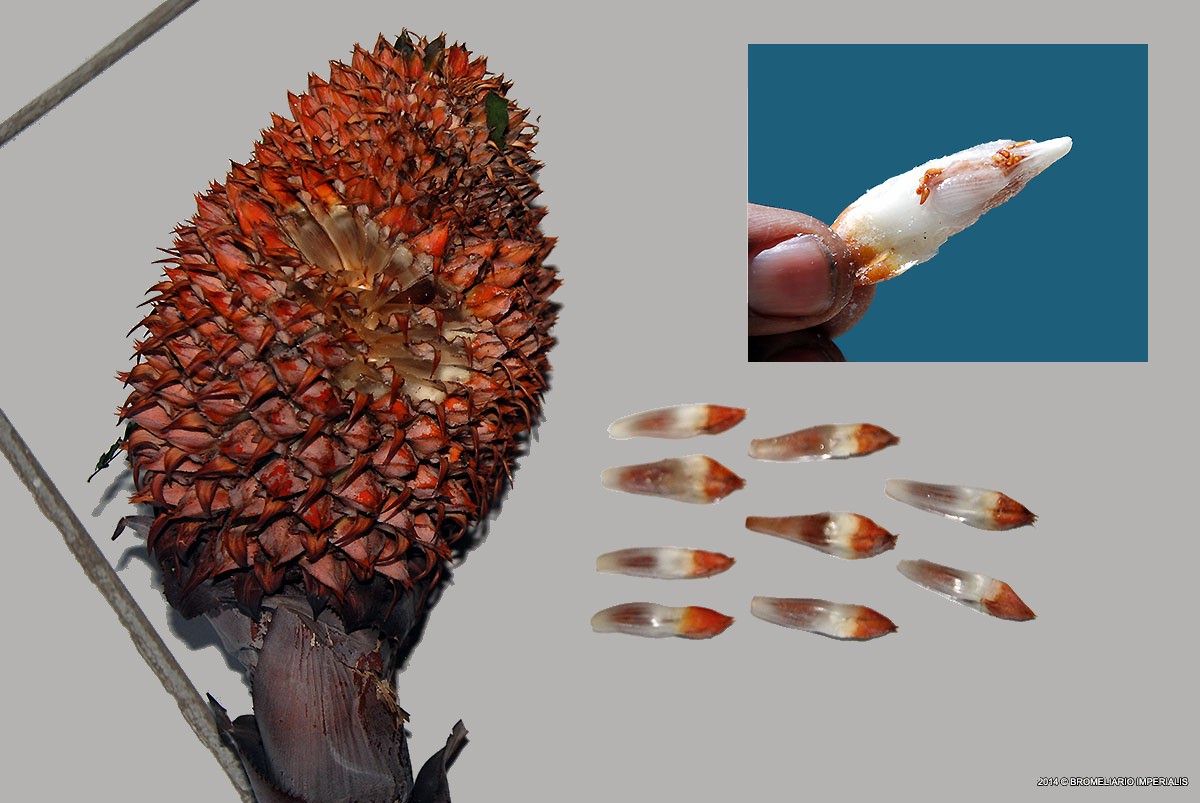
These days the trend seems to be to create new genera rather than trying to solve the problem at sub-genus level. This in turn creates problems with naming of man-made hybrids. In this case a quick check of the Bromeliad Cultivar Register has revealed that none of the 7 taxa have been reported. All named have impressive inflorescences but are large plants and take many years to flower which may be the cause of reluctance to hybridise.



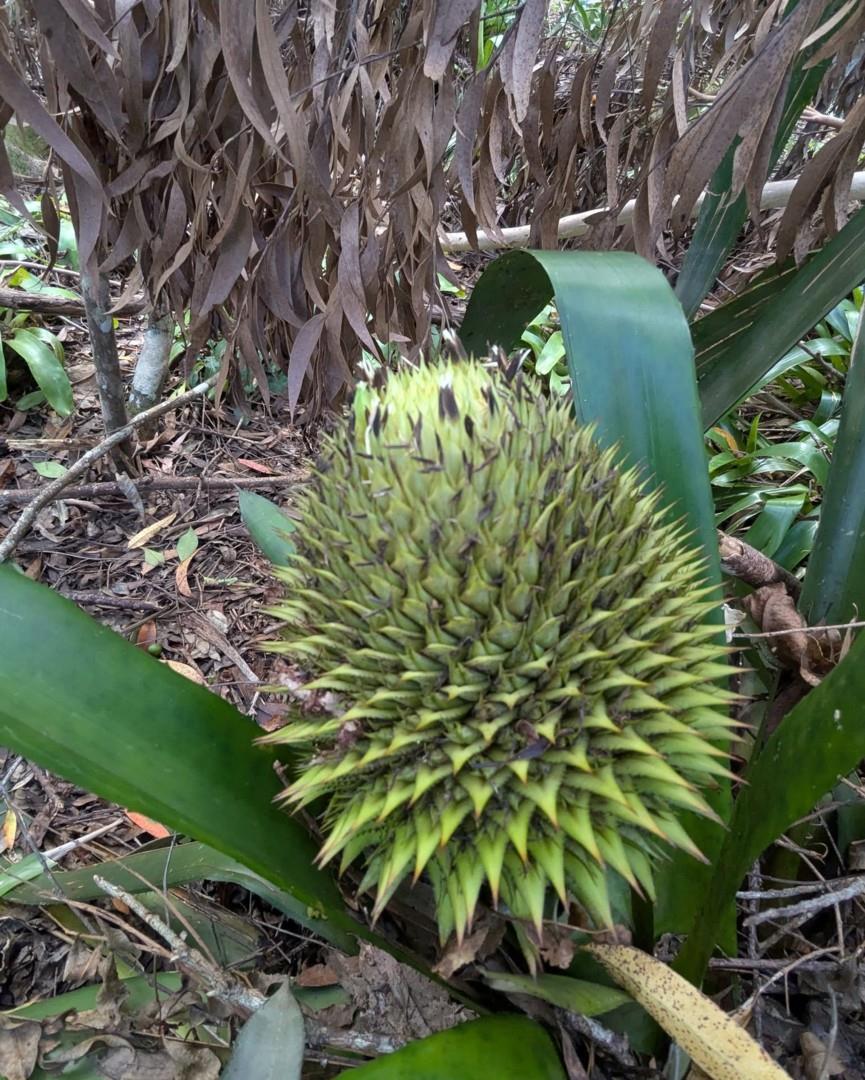
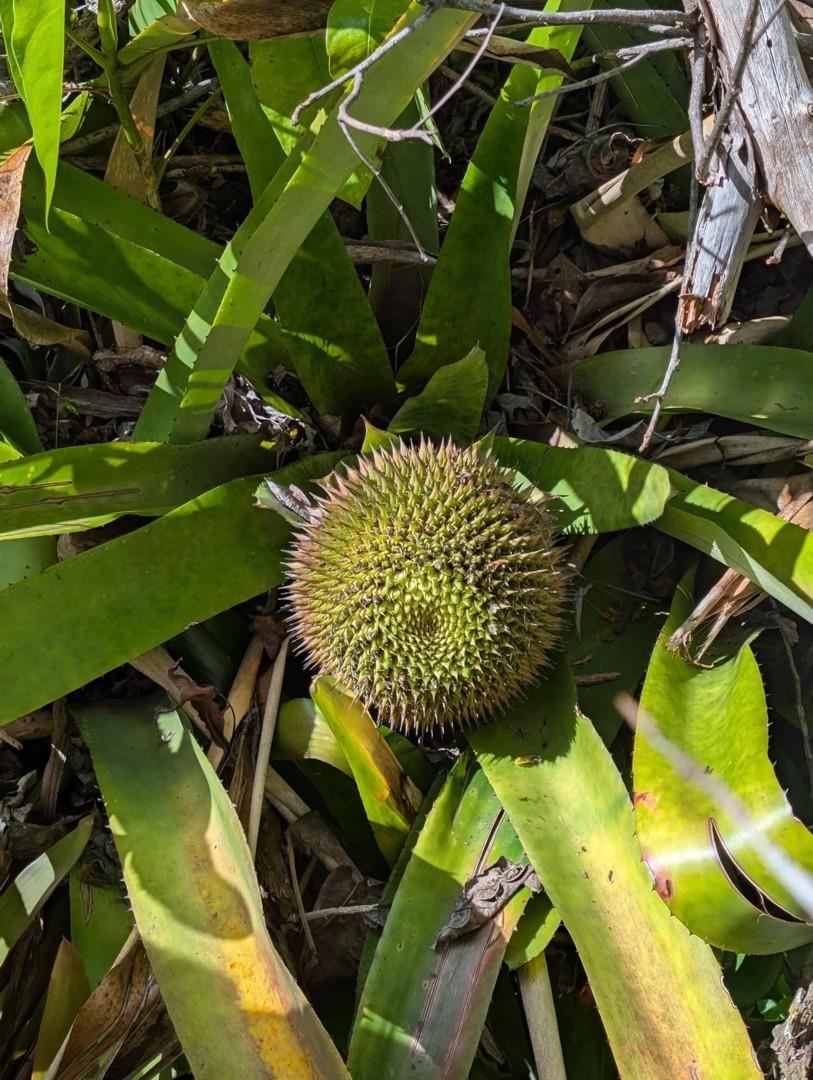
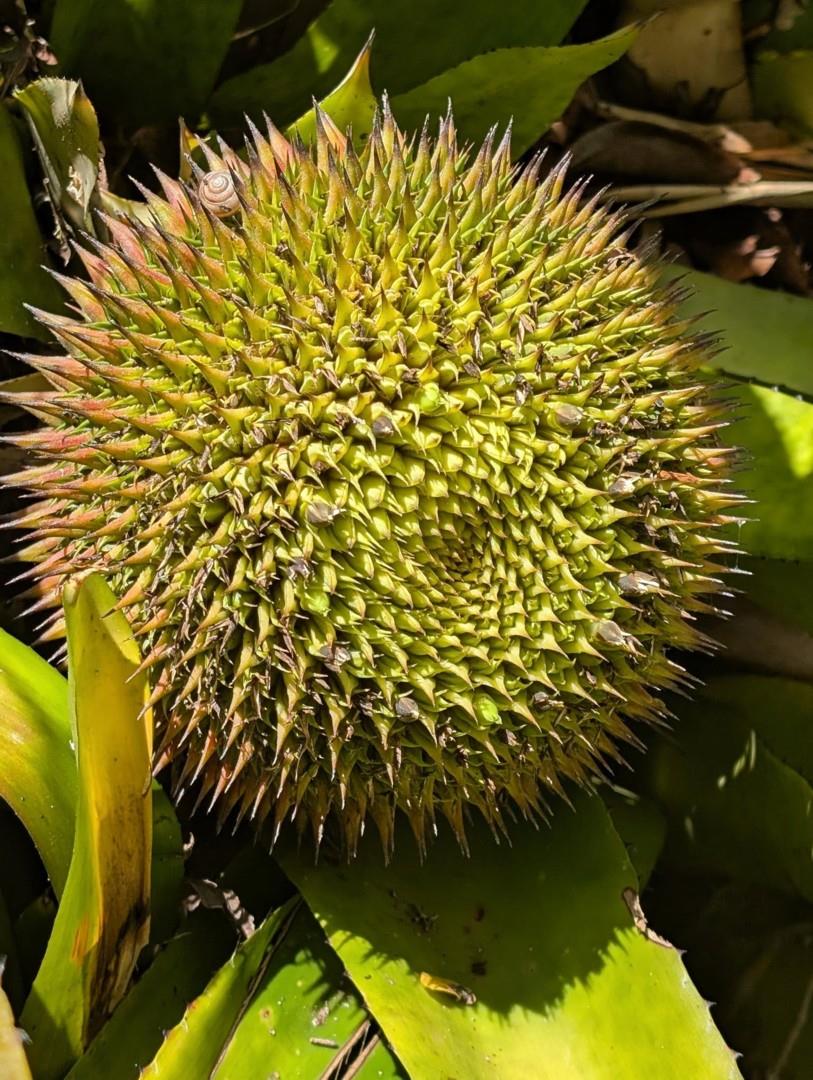

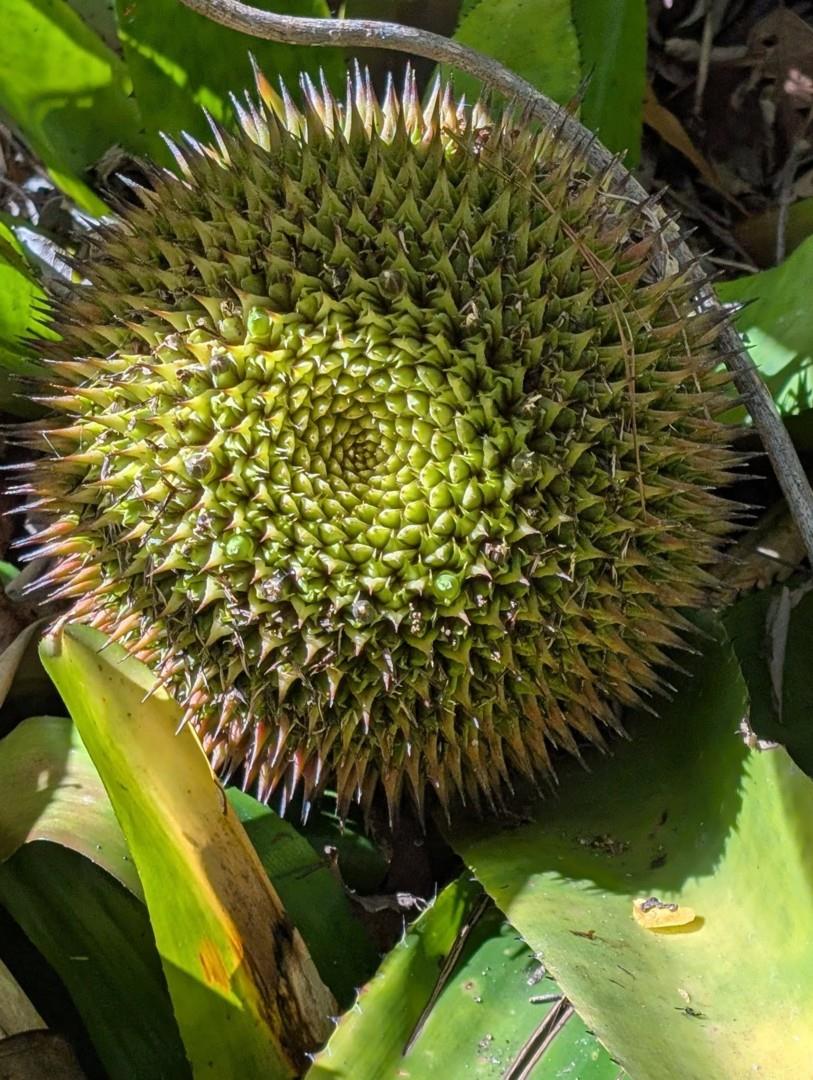

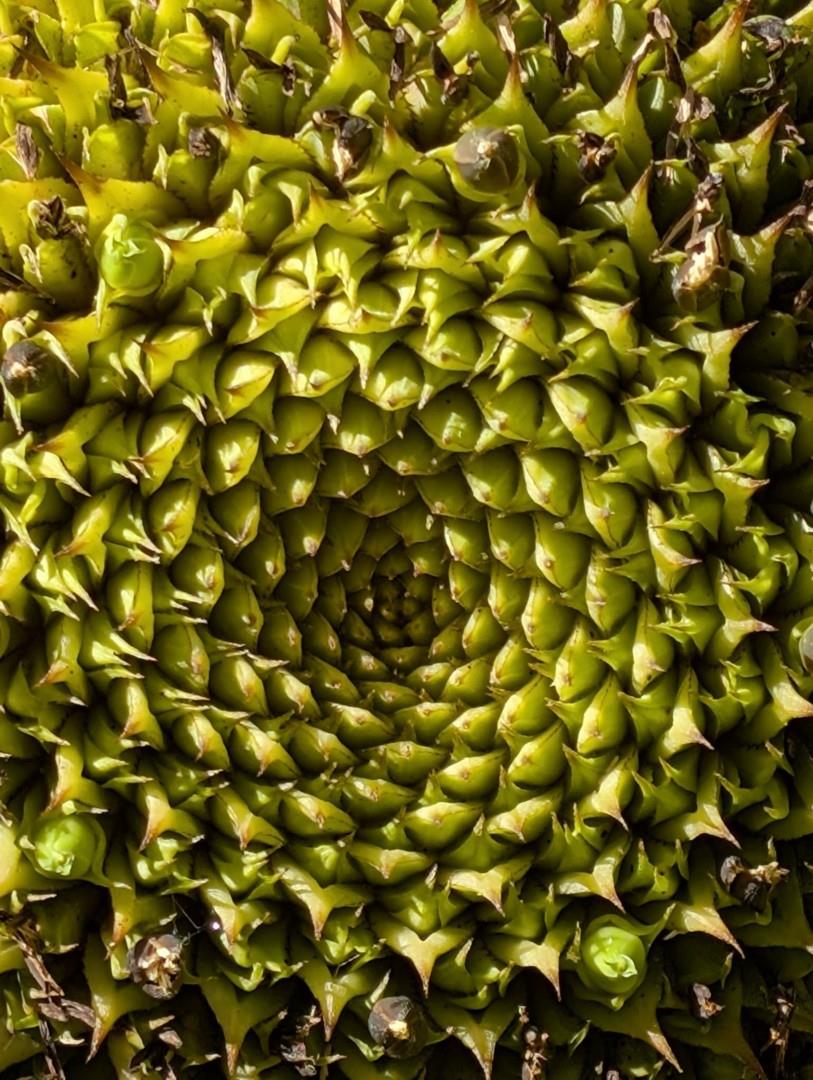
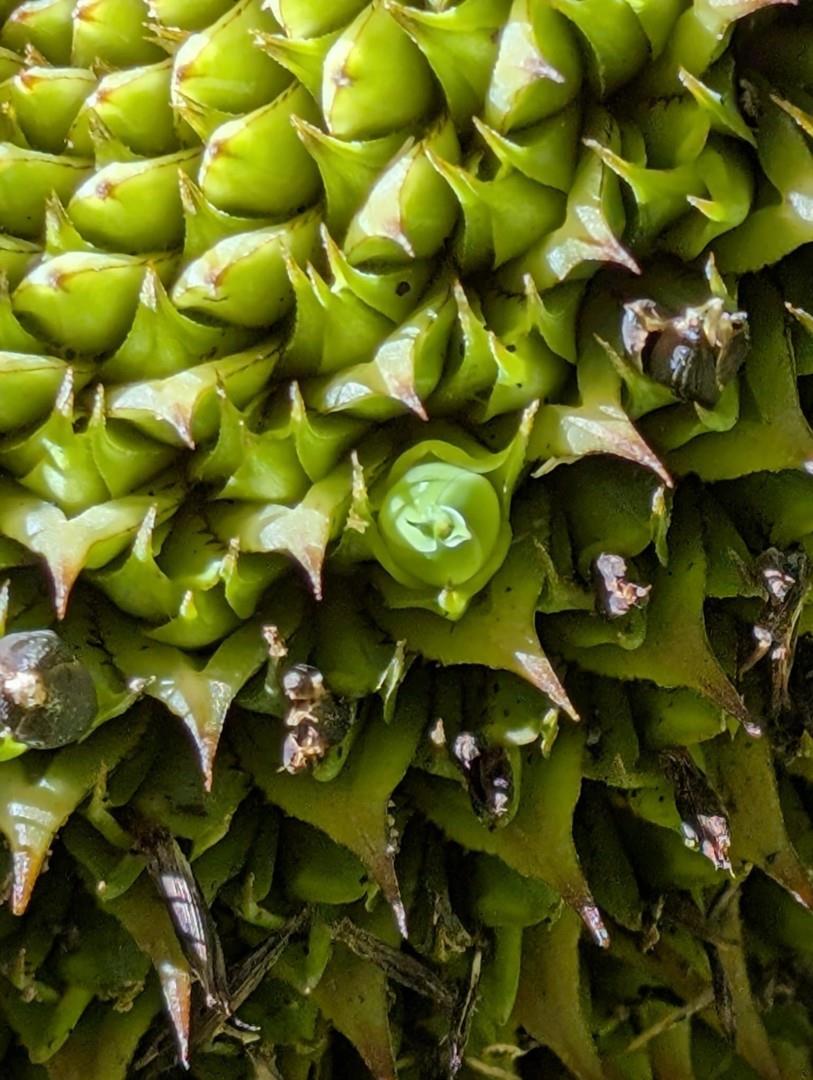

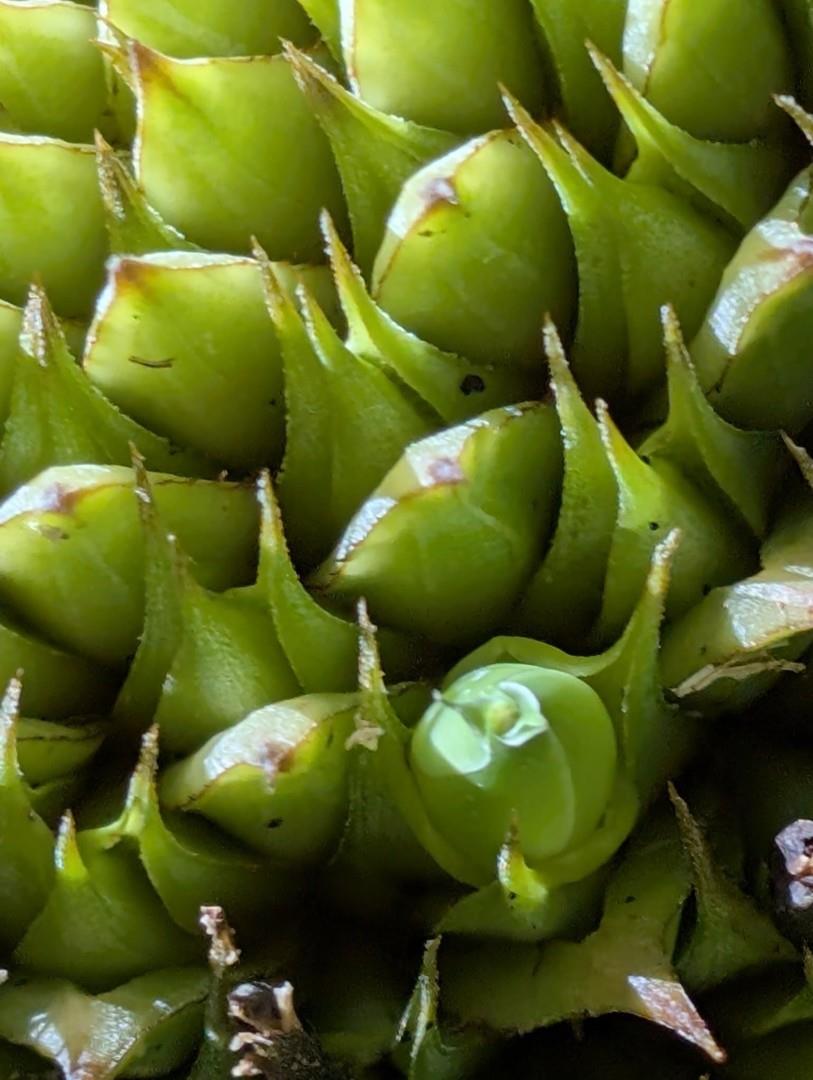
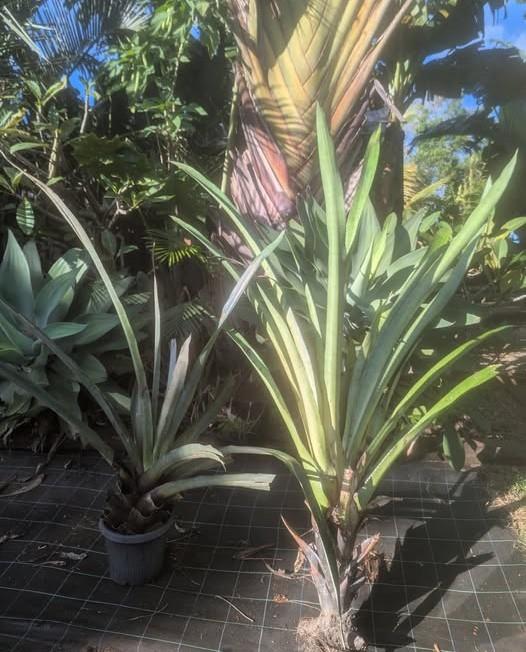
Terrestrial or epiphytes, ca. 1.5 m tall.
Leaves 100–280 cm long;
leaf sheath 35–40 x 16–19 cm, elliptical;
leaf blades 60–280 x 11–14 cm, green to yellow-green, flattened, oblong, apical spines ca. 1 cm long, prickles in margins ca. 1 mm long.
Inflorescence ovate 11–16.5 cm long, axis elongated, enlarged; mucilage absent; peduncle 60–120 cm long, green, white-lepidote;
peduncle bracts 13–15 x 5–7 cm, triangular, green in basal portion, red in apical portion, white-lepidote, apical spines ca. 1.3 cm, margins serrate;
involucral bracts red.
Floral bracts 3–4.5 x 1.2–2.5 cm, spatulate, red, white-lepidote, apex cuspidate, spreading or reflexed, margins entire in basal portion, serrate in apical portion, exceeding the sepals length.
Flowers 3–3.5 cm long.
Sepals 1.5–1.7 cm long, dark-green, imbricate, dorsally white-lepidote, two carinate and one without carina, apex mucronate.
Petals free above epigynous tube, 1.5–2 x 0.5–0.7 cm, ovate, pallid-green, margins white, apex acute, erect;
petal appendages free in basal portion, cupuliform, erose margins.
Stamens of external series with free filaments over epigynous tube, 1–1.2 cm long, of internal series epipetalous, free, 3–4 mm long;
anthers 7–8 mm, basifixed, linear.
Ovary 1–1.3 cm long; epigynous tube 5–8 mm long; style stout; stigma margins digitate. Fruits 3–5 cm long, castaneous. Seeds 3–4 mm, castaneous. Figures 5C–D, 8.
Distribution, Habitat, and Conservation— Karawata multiflora has the widest distribution in Atlantic Forest among the species of Karawata (Fig. 4). It can be found as terrestrial or epiphyte in restingas (open coastal forest in sandy soils), ombrophilous forest and seasonally dry forest from 50 to 400 m elevation. Flowering and fruiting all year. Karawata multiflora is dominant in bromeliad communities in some places, such as the vicinity of Marau in southern Bahia state (Maciel et al. 2015). Because of its large distribution and good conservation of natural populations this species is evaluated as 'Least Concern'. In addition, populations of K. multiflora are protected in natural reserves in Brazil.
Comments— Inflorescences of this species have a variation in color depending on flower maturation. The young inflorescence is often green and becomes orange to red during the flowering period. This species is clearly morphologically related to K. depressa as discussed before. Moreover, distributions of K. multiflora and K. depressa overlap, which leads to identification errors. Nevertheless, K. multiflora can be easily identified by its elongate inflorescences and floral bracts with apex reflexed (Fig. 8).
Representative Specimens Examined— Brazil. —ALAGOAS: Feliz Deserto, 04 November 1979 (fr), D. Andrade-Lima 79–8772 (IPA).—BAHIA: Boa Nova, Parque Nacional de Boa Nova, 14deg19'56" S, 40deg12'52"” W, 16 December 2013 (fr), J.R.Maciel et al. 1861 (UFP); Marau, 14deg07'43"S 39deg00'09"W, 02 February 2000 (fr), M. Alves et al. 1901 (CEPEC, HUEFS, NY, SP); Salvador, Parque das Dunas, 12deg55'04" S, 38deg19'02" W, December 2013 (fl, fr), J.R. Maciel & B.S. Amorim 1837 (UFP).—SERGIPE: Pirambu, Reserva Biologica de Santa Isabel, 10deg47'19"S 36deg58'35"W, 16 June 2000 (fl, fr), G. Sousa et al. 358 (CEPEC, SP).
PLANT terrestrial or epiphltic, flowering 50-150 cm tall.
LEAVES strongly coriaceous greatly exceeding the inflorescence, forming a broad crateriform rosette;
SHEATHS narrowly oblong-elliptic, 28-40 x 10-19 cm, dark castaneous and densely brown-lepidote on both sides;
BLADES sublinear, acuminate and ending in a dark castaneous, stout, rigid spine ca. 1 cm 1ong, slightly if at all narrowed toward the base, 85-180 x 8-14 cm, glabrescent adaxially inconspicuously to densely white-lepidote abaxially margins densely spinose, spines subtriangular-uncinate, the basal ones retrorse, the upper ones antrorse, brown, 1-2 mm long, 3-10 mm apart.
SCAPE erect to suberect, 34-55, cm long, ca. 23 cm in diameter, coarsely white-lepidote to glabrescent with age, greenish-white to castaneous;
SCAPE BRACTS acute and ending in a dark castaneous, stout, rigid spine ca. 1 cm long, very coriaceous, erect except for the suberect apex, distinctly exceeding the internodes and almost completely concealing the scape, greenish at apex, dark castaneous toward the base, densely and coarsely white-lepidote, nerved, very densely spinose with dark castaneous spines ca. 1 mm long, ca 1 mm apart, the basal ones subfoliaceous, the others subtriangular, ca. 7.5 x 6.5 cm, the upper ones much smaller densely clustered below the inflorescence, strongly recurved, slightly resembling the basal floral bracts, ca. 2.5 x 3 cm..
INFLORESCENCE simple, very densely strobilaceous, globose-ovoid to subcylindrical, erect, 9-30 x 7.5-20 cm, compressed in early anthesis to 5 to 6 times longer during late anthesis, apex rounded and bearing an inconspicuous coma of short sterile bracts;
FLORAL BRACTS with a suboblong to obovate, cymbiform, very densely spinulose base and with a narrowly triangular, acuminate, entire, flat, distinctly recurved apex, enfolding the base of the flowers but strongly recurved and exposing the calyx, rose to red, densely white-lepidote toward the apex, coriaceous, ecarinate, the basal ones equalling to exceeding the sepals, 30-50 x 15-20 mm, the upper ones equalling to shorter than the sepals, 25-30 x 9-10 mm.
FLOWERS numerous, 35-40 mm long, sessile, polystichously and very densely arranged, dorsiventrally compressed;
SEPALS suboblong-ovate, subobtuse to obtuse and mucronulate, asymmetrical with a subrounded lateral wing which nearly equals the mucro, 10-18 x 9-10 mm, including the ca 1 mm long apical mucro, free to connate at base to 3 mm, green, densely and coarsely white-lepidote, the posterior ones sharply alate-caitate with the keels decurrent on the ovary;
PETALS lanceolate-ovate, apex narrowly rounded and minutely apiculate, appearing acuminate due to the inrolled apical margins, erect at anthesis, 16-21 x 6-7 mm, free, green, bearing at base 2 cupulate, obtuse, entire to slightly crenulate appendages ca 3 mm above the base in connection with 2 conspicuous, lateral callosities dentate at apex;
STAMENS included;
FILAMENTS complanate and dilated toward the apex, the antepetalous ones adnate to the petals for ca. 5 mm, the antesepalous ones free;
ANTHERS linear, base inconspicuously obtuse-sagittate, apex obtuse, 6-7 mm long, dorsifixed slightly below the middle;
POLLEN globose, inconspicuously sulcate, exine appearing rugulose-psilate,
STIGMA conduplicate-spiral, ovate, greenish, blades lacerate-fimbriate;
OVARY subclavate, 18-20 mm long, ca. 5 mm wide at base, 10-15 mm wide at apex, white, densely and coarsely white-lepidote; placentation subapical; ovules caudate; epigynous tube 4-6 mm long.
FRUITS unknown.
Type: Bahia, Forests of Rio Grongogi basin, 100-500 m elev., 1 Oct.- 30 Nov 1915, H. M. Curran 297 (US)
MATERIAL EXAMINED
ALAGOAS: Feliz Deserto, Restinga, 4 Nov 1979, A Lima 79-8772 (lPA); Placabucu, 4 Nov. 1979, A. Lima 79-8763 (lPA); Maragogi, 11 Oct 1980, A Lima 80-8813 (lPA); Coruripe, Usina Guaxuma, Mata da Bomba Quinze, 31 Oct. 2004, J A Siqueira-Filho 1436, E. Leme & J. B. Oliveira, cult. Bbio 53 (UFP).
DISCUSSION
Even after several attempts, we found no flowering plants in the type region that would provide us with more information on the variation pattern of Aechmea frassyi. For this reason, we adopt the broad concept of A. multiflora proposed by Sousa (2004), who revised subgenus Chevaliera and synonymized A. frassyi on the grounds that it was well within the limits of morphological variation for A. multiflora.
According to Canela et al. (2003), A. multiflora forms a species complex with A. depressa L. B. Sm. and A. saxicola L. B. Sm. A. hostilis E. Pereira should also be included in this complex. Of these species, A. saxicola (found in Espirito Santo and Rio de Janeiro) seems to be most similar to A. multiflora.
Aechmea multiflora is distinguished by the following traits (Canela et al. 2003): the inflorescence grows to 5 to 6 times its original length by the end of anthesis (vs. only 2 to 3 times), the petals are shorter (16-21 mm vs. 25-35 mm), free (vs partially connate), about equalling sepal length (vs. exceeding sepal length), and floral bracts spinulose for 1/3 margin length (vs spinulose for 2/3 margin length).
Aechmea multiflora is a terrestrial plant on sandy soils in the shrubby to arboreal Restinga and also grows in the adjacent lowland Atlantic forest, where it is found on the forest floor and as an epiphyte. Populations are concentrated especially on the coast of Bahia, ranging to Alagoas and Sergipe (unpublished data, in part). Several residual populations of A. multiflora in Alagoas are protected on private property like the Mata da Bomba Quinze in Usina Guaxuma, and the Mata de Capiata, an outpost of the Atlantic Forest Biosphere Reserve belonging to Usina Coruripe.
Aechmea multiflora flowers in the dry season from October to December. Phaethornis ruber was seen visiting the flowers at Mata da Bomba Quinze in Coruripe.
Plants flowering to a height of c. 100 cm.
LEAF BLADES green, linear, 85-231 x 11-14 cm, apex pungent 10 mm long, densely serrate with dark spines up to 5 mm long, some of them retrorse.
LEAF SHEATHS adaxially nigrescent and abaxially white-greenish, elliptic, 38-40 x 15-19 cm long.
SCAPE stout, 55 cm long, scape bracts imbricate, ovate, apex pungent 10 mm long, densely serrate.
INFLORESCENCE strobiliform, 5-29 x 9-11 cm long (up to c. 36 x 16 cm in fresh material), compressed early in development and elongating 5-6 times during development.
FLORAL BRACTS red at the apices, oblong and slightly concave, 40-58 x 6-30 mm, obtuse-acuminate in pungent apices 6-13-mm long, margin c. 1/3 serrate.
FLOWERS compressed against each other, sessile, c. 40 mm long.
SEPALS fused for 3 mm, castaneous greenish at the apices, ovate, strongly asymmetric, two of them carinate, 15-29 x 9-11 mm, apex obtuse ending in a stout spine of 3-4 mm long.
PETALS free, white yellowish, lanceolate,l7-20 x 5 mm, not exceeding the calyx length.
STAMENS six, free.
OVARY inferior, compressed, laterally alate-carinate, epigynous tube c. 5 mm long.
OVULES many, caudate, smaller than 1 mm long.
SEEDS fusiform, c. 3 mm long.
Distribution and habitat
Aechmea multiflora occurs in Sergipe and Bahia states. It grows epiphytically or terrestrially in tropical mesophytic forest and mangrove swamps (Fig. 9). Smith & Downs (1979: 1942) indicated this species as also occurring in Espirito Santo. However, our examination of collections did not confirm this.
Collections examined
BRAZIL: without specific locality, in cultivation on Sitio Roberto Burle Marx at Rio de Janeiro, 6.iii.1998. Canela 1, Prado & Wendt (RB, RFA). SERGIPE: Santa Luzia do Itanhi, 27.xi.1993, Amorim 1480 (CEPEC). BAHIA: Rio Gongogi, l.x-30.xi.1915, Curran 297 (US, K); Cachoeira, Morro Belo, Vale dos rios Paraguagu e Jacuipe, 13.viii.1981, Grupo Pedra do Cavalo 496 A (ALCB); Ipira, Fazenda do Recreio, Estrada do Feijao, 4.x.1986, Queiroz 957 (HUEFS, MBM); Valente, Santa Barbara, 29.xiii.1992, Queiroz 3018, Serra & Sampaio (HUEFS, MBM).
Aechmea frassyi Leme & Siqueira, Selbyana 22(2): 146-7. 2001
TYPE: E. Leme 5086 (Holotype: HB). Brazil. Alagoas: field collected by Artur Frassy s.n., 17 Jan. 2001, between Feliz Deserto and Piacabucu, in sandy coastal plain vegetation, flowered in cultivation, Feb. 2001,
A Aechmea multiflora LB. Sm., cui affinis, foliis dense spinosis, spinis minoribus, inflorescentia ca. 9 cm longa, ca. 7.5 cm lata, bracteis floriferis supernis attitudinem sepalorum distincte brevioribus, roseis, sepalis duplo minoribus, viridibus, dense albo-lepidotis, apice mucronulatis, petalis acuminatis differt.
Plant terrestrial Leaves strongly coriaceous, exceeding the inflorescence, forming a broad crateriform rosette.
Sheaths narrowly oblong-elliptic, ca. 28 X 10 cm, dark castaneous and densely brown-lepidote on both sides.
Blades sublinear, acuminate and ending in a dark castaneous, stout, rigid spine ca. 1 cm long, slightly if at all narrowed toward base, 85 x 8-9 cm, glabrescent adaxially, inconspicuously white lepidote abaxially, margins densely spinose, spines subtriangular-uncinate, mostly antrorse, brown, 1-2 mm long, 3-8 mm apart.
Scape erect to suberect, ca. 45 cm long, ca. 2.3 cm in diameter, coarsely white-lepidote, becoming glabrescent with age, greenish-white to castaneous.
Scape bracts acute and ending in a dark castaneous, stout, rigid spine ca. 1 cm long, coriaceous, erect except for the suberect apex, distinctly exceeding the internodes and almost completely concealing the scape, greenish at apex, dark castaneous toward base, densely and coarsely white-lepidote, nerved, densely spinose with dark castaneous spines ca. 1 mm long, ca. 1 mm apart, the basal bracts subfoliaceous, the others ones subtriangular ca. 7.5 x 6.3 cm, the upper bracts much reduced, massed below the inflorescence, strongly recurved, slightly resembling the basal floral bracts, ca. 2.3 x 3 cm.
Inflorescence simple, densely strobilate, globose-ovoid, erect, ca. 9 cm long, ca. 7.5 cm in diameter, apex rounded and bearing an inconspicuous coma of short sterile bracts.
Floral bracts with a suboblong to obovate, slightly cymbiform, densely spinulose base and a narrowly triangular, acuminate, entire, flat, distinctly recurved apex, enfolding the base of the flowers but completely exposing the calyx, rose and densely white-lepidote toward apex, coriaceous, ecarinate, the basal ones equaling to slightly exceeding the sepals, ca. 30 x 15 mm, the upper ones shorter than the sepals, ca. 25 x 9 mm.
Flowers ca. 120 in number, ca. 40 mm long, sessile, polystichously and densely arranged, dorsiventrally compressed.
Sepals suboblongovate, subobtuse and mucronulate, asymmetrical with a subrounded lateral wing which equals their mucro, 10-13 mm long including the ca. 1 mm long apical mucro, ca. 9 mm wide, free, green, densely and coarsely white-lepidote, the adaxial pair sharply alate-carinate with keels decurrent on the ovary.
Petals lanceolate, acuminate, erect at anthesis, ca. 20 x 6 mm, free, green, bearing at base 2 cupulate, obtuse, entire to slightly crenulate appendages ca. 3 mm above the base, connected to 2 conspicuous, lateral callosities dentate at apex.
Stamens included.
Filaments complanate and dilated toward apex, the antepetalous ones adnate to the petals for ca. 5 mm, the antesepalous free.
Anthers linear, base and apex obtuse, ca. 6 mm long, fixed near the middle.
Stigma unknown.
Ovary subclavate, ca. l8 mm long, ca. 5 mm wide at base, ca: 15 mm wide at apex, white, densely and coarsely white lepidote; ovules not completely known, apparently caudate; epigynous tube ca. 4 mm long.
Aechmea frassyi, referred to subgenus Chevaliera, is closely related to A. multiflora. The new species may be distinguished, however; by its densely spinose leaves with smaller spines (1-2 mm vs. 5 mm); inflorescence ca. 9 cm long (vs. 15-29 cm) and ca. 7.5 cm wide only (vs. 11-20 cm); upper floral bracts much shorter and distinctly exceeded by sepals, rose colored (vs. reddish-brown); sepals only half as long (10-13 mm vs. 20-25 mm), green (vs. brownish), densely white-lepidote, apex mucronulate; and by the acuminate petals.
This species is named in honor of the bromeliad collector Artur Frassy of Alagoas state. He has discovered new species and has introduced other rare ones into horticulture.